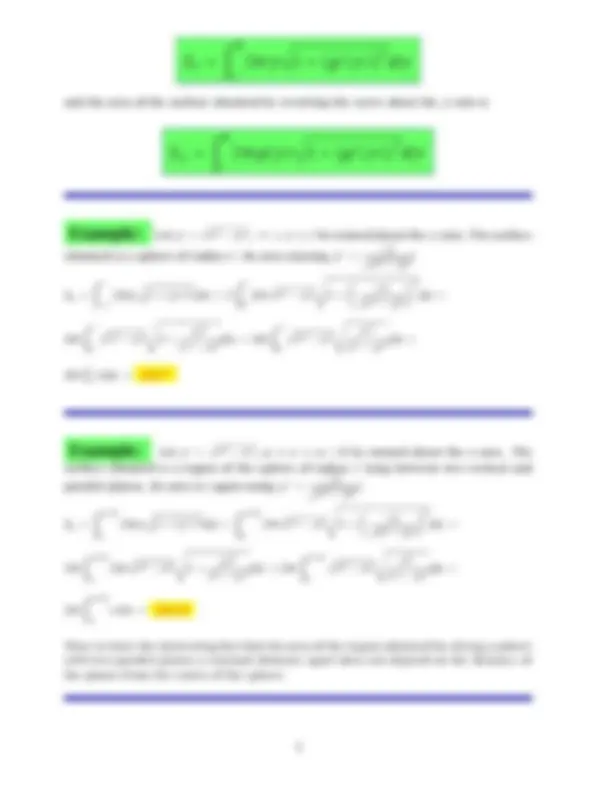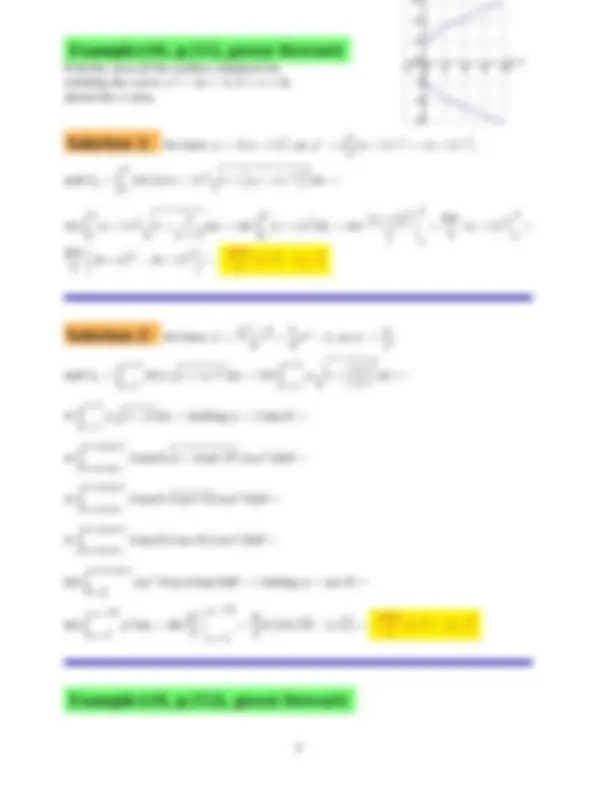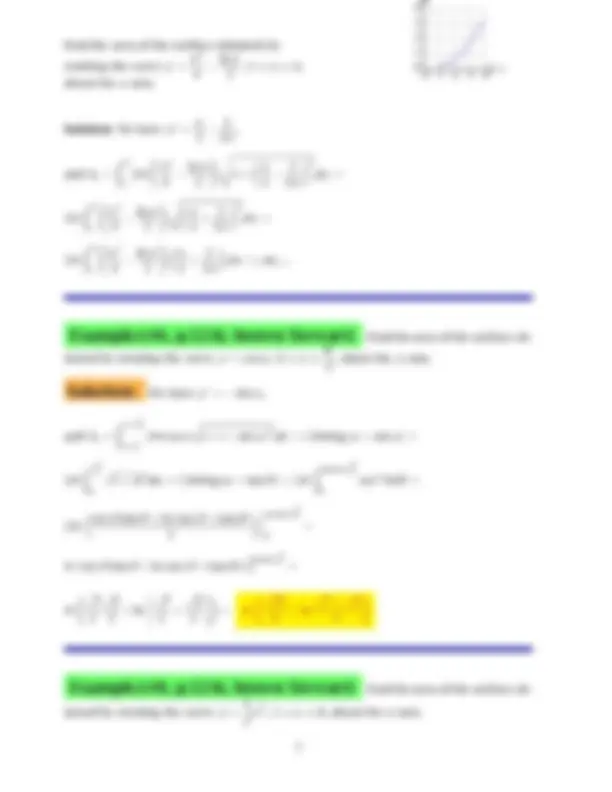





Study with the several resources on Docsity

Earn points by helping other students or get them with a premium plan


Prepare for your exams
Study with the several resources on Docsity

Earn points to download
Earn points by helping other students or get them with a premium plan
Community
Ask the community for help and clear up your study doubts
Discover the best universities in your country according to Docsity users
Free resources
Download our free guides on studying techniques, anxiety management strategies, and thesis advice from Docsity tutors
Formulas and examples for calculating the area of frustums and surfaces of revolution. It covers the calculation of the area of sectors of circles, the area of frustums, and the area of surfaces obtained by revolving curves about the x- and y-axes. various examples and solutions for finding the area of surfaces of revolution.
What you will learn
Typology: Study notes
1 / 6

This page cannot be seen from the preview
Don't miss anything!




U
n
iv ersity o f
S a s k at che w
a
n
DEO ET
PAT- RIE
Let a cone have height h and radius r , so that the circumference of the base is 2 π r. If
the cone is cut along a straight line (of length R =
r 2
and flattened out, we obtain a sector of the circle whose radius is R. The area of the
circle of radius R is π R
2 = π (r
2
2 ) , so the ratio of the area of the sector to that of
the circle is
2 π r
2 π R
r
, so the area of the sector is
r
π R
2 = π r
r
2
2 .
If we now take two cones, with one being a subset of the other, we can calculate the area
of the region between the bases of the two cones. This region is called a frustum.
h 1
r 1
r 2
Let the larger and smaller cones have heights and radii h 2 and r 2 and h 1 and r 1.
Let R 2 =
r
2 2
2 2 and R 1 =
r
2 1
2 1 , so that the areas of the larger and smaller cones
are
A 2 = π r 2
r
2 2 +^ h
2 2 and^ A^1 =^ π r^1
r
2 1 +^ h
2 1
U
n
iv ersity o f
S a s k at che w
a
n
DEO ET
PAT- The area of the frustum is thus RIE
A = A 2 − A 1 = π r 2
r
2 2
2 2 − π r 1
r
2 1
2 1
π
r 2
r
2 2 +^ h
2 2 −^ r^1
r
2 1 +^ h
2 1
= π (r 2 R 2 − r 1 R 1 )
Writing R = R 2 − R 1 and r =
r 1 + r 2
, and using similar triangles, we derive
A = 2 π r R.
We can then use this formula to derive a formula for the area of the surface obtained
by rotating the curve (x(t), y(t)) , t 1 ≤ t ≤ t 2 about the x - and y −axes respectively:
t 2
t 1
y
t 2
t 1
If the curve is the graph of a function y = f (x) , a ≤ x ≤ b , then the area of the surface
obtained by revolving the curve about the x -axis is
x
b
a
and the area of the surface obtained by revolving the curve about the y -axis is
b
a
If the curve is the graph of a function x = g(y) , c ≤ x ≤ d , then the area of the surface
obtained by revolving the curve about the x -axis is
Find the area of the surface obtained by
rotating the curve y
2 = 4 x + 4, 0 ≤ x ≤ 8,
about the x -axis.
1 (^2) , so y ′ = 2
(x + 1 )
−
1 (^2) = (x + 1 ) −
1 (^2) ,
and Sx =
8
0
2 π ( 2 )(x + 1 )
1 2
(x + 1 )
−
1 2
2 dx =
4 π
8
0
(x + 1 )
1 2
x + 1
dx = 4 π
8
0
(x + 2 )
1 (^2) dx = 4 π
(x + 2 )
3 2
3 2
8
0
8 π
(x + 2 )
3 2
8
0
8 π
3 2 − ( 0 + 2 )
3 2
16 π
y
2 − 4
y
2 − 1, so x
y
and S (^) x =
y = 6
y = 2
2 π y
1 + (x ′ )
2 dy = 2 π
y = 6
y = 2
y
y
2
dy =
π
y = 6
y = 2
y
4 + y 2 dy = (letting y = 2 tan θ) =
π
θ =arctan 3
θ =arctan 1
2 tan θ
4 + 4 tan
2 θ
2 2 sec
2 θdθ =
π
θ =arctan 3
θ =arctan 1
2 tan θ
4 sec 2 θ 2 sec
2 θdθ =
π
θ =arctan 3
θ =arctan 1
2 tan θ( 2 sec θ) 2 sec
2 θdθ =
8 π
θ =arctan 3
θ =
π 4
sec
2 θ sec θ tan θdθ = ( letting u = sec θ) =
8 π
u =
√ 10
u =
√ 2
u
2 du = 8 π
u
3
u =
√ 10
u =
√ 2
π
16 π
Find the area of the surface obtained by
rotating the curve y =
x
2
ln x
, 1 ≤ x ≤ 4,
about the x -axis.
Solution: We have y
x
2 x
and S (^) x =
4
1
2 π
x
2
ln x
x
2 x
dx =
2 π
4
1
x
2
ln x
x
2 x
dx =
2 π
4
1
x
2
ln x
x
2 x
dx =, etc....
tained by rotating the curve y = cos x , 0 ≤ x ≤
π
, about the x -axis.
′ = − sin x ,
and S (^) x =
x =
π 3
x = 0
2 π cos x
1 + ( − sin x)
2 dx = ( letting u = sin x) =
2 π
√ 3 2
0
1 + u 2 du = ( letting u = tan θ) = 2 π
arctan
√ 3 2
0
sec
3 θdθ =
2 π
sec θ tan θ + ln |sec θ + tan θ |
arctan
√ 3 2
0
π ( sec θ tan θ + ln |sec θ + tan θ | ) |
arctan
√ 3 2 0 =
π
= π
tained by rotating the curve y =
x
2 (^3) , 1 ≤ x ≤ 8, about the x -axis.